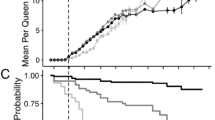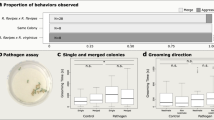Abstract
One of the main transitions in evolution is the shift from solitary organisms to societies with reproductive division of labour1,2. Understanding social evolution requires us to determine how ecological, social and genetic factors jointly influence group stability and partitioning of reproduction between group members3,4,5,6,7,8. Here we test the role of the three key factors predicted to influence social evolution by experimentally manipulating them in a social allodapine bee. We show that increased relatedness between nestmates results in more even reproduction among group members and a greater productivity per individual. By contrast, the degree of reproductive skew is not influenced by the opportunity for solitary breeding or by the potential benefits of cooperation. Relatedness also has a positive effect on group stability and overall productivity. These findings are in line with predictions of the tug-of-war models, in which the degree of reproductive division of labour is determined primarily by selfish competition between group members. The alternative view, where the degree of reproductive skew is the outcome of a social contract between potential breeders, was not supported by the data.
This is a preview of subscription content, access via your institution
Access options
Subscribe to this journal
Receive 51 print issues and online access
$199.00 per year
only $3.90 per issue
Buy this article
- Purchase on Springer Link
- Instant access to full article PDF
Prices may be subject to local taxes which are calculated during checkout




Similar content being viewed by others
References
Maynard Smith, J. & Szathmáry, E. The Major Transitions in Evolution (W. H. Freeman, Oxford, 1995)
Keller, L. (ed.) Levels of Selection in Evolution (Princeton Univ. Press, Princeton, 1999)
Keller, L. & Reeve, H. K. Partitioning of reproduction in animal societies. Trends Ecol. Evol. 9, 98–102 (1994)
Field, J., Solis, C. R., Queller, D. C. & Strassmann, J. E. Social and genetic structure of paper wasp cofoundress associations: tests of reproductive skew models. Am. Nat. 151, 545–563 (1998)
Johnstone, R. A. Models of reproductive skew: a review and synthesis. Ethology 106, 5–26 (2000)
Reeve, H. K. & Keller, L. Tests of reproductive-skew models in social insects. Annu. Rev. Entomol. 46, 347–385 (2001)
Clutton-Brock, T. H. et al. Cooperation, control, and concession in meerkat groups. Science 291, 478–481 (2001)
Haydock, J. & Koenig, W. D. Reproductive skew in the polygynandrous acorn woodpecker. Proc. Natl Acad. Sci. USA 99, 7178–7183 (2002)
Vehrencamp, S. L. A model for the evolution of despotic versus egalitarian societies. Anim. Behav. 31, 667–682 (1983)
Emlen, S. T. The evolution of helping. I. An ecological constraints model. Am. Nat. 119, 29–39 (1982)
Reeve, H. K. & Ratnieks, F. L. W. in Queen Number and Sociality in Insects (ed. Keller, L.) 45–85 (Oxford Univ. Press, Oxford, 1993)
Johnstone, R. A. & Cant, M. A. Reproductive skew and the threat of eviction: a new perspective. Proc. R. Soc. Lond. B 266, 275–279 (1999)
Reeve, H. K., Emlen, S. T. & Keller, L. Reproductive sharing in animal societies: reproductive incentives or incomplete control by dominant breeders? Behav. Ecol. 9, 267–278 (1998)
Schwarz, M. P., Bull, N. J. & Hogendoorn, K. Evolution of sociality in the allodapine bees: a review of sex allocation, ecology and evolution. Insectes Soc. 45, 349–368 (1998)
Silberbauer, L. X. & Schwarz, M. P. Life-cycle and social-behavior in a heathland population of the allodapine bee, Exoneura bicolor (Hymenoptera, Apidae). Insectes Soc. 42, 201–218 (1995)
Schwarz, M. P. Female-biased sex-ratios in a facultatively social bee and their implications for social evolution. Evolution 48, 1684–1697 (1994)
Silberbauer, L. X. Founding patterns of Exoneura bicolor in Cobboboonee State Forest, S.W. Victoria. Aust. Zool. 28, 67–73 (1992)
Bull, N. J. & Schwarz, M. P. The habitat saturation hypothesis and sociality in an allodapine bee: cooperative nesting is not ‘making the best of a bad situation’. Behav. Ecol. Sociobiol. 39, 267–274 (1996)
Stevens, M. I. Egg Stock Piling Strategies and Benefits to Group Living in Exoneura bicolor Smith (Apidae, Xylocopinae) Thesis, Flinders Univ. South Australia, Adelaide (1997)
Gadagkar, R., Chandrashekara, K., Chandran, S. & Bhagavan, S. Queen success is correlated with worker–brood genetic relatedness in a primitively eusocial wasp (Ropalidia marginata). Experientia 49, 714–717 (1993)
Hogendoorn, K. & Zammit, J. Benefits of cooperative breeding through increased colony survival in an allodapine bee. Insectes Soc. 48, 392–397 (2001)
Reeve, H. K. in The Social Biology of Wasps (eds Ross, K. G. & Matthews, R. W.) 99–148 (Cornell Univ. Press, Ithaca, 1991)
Kokko, H. Are reproductive skew models evolutionarily stable? Proc. R. Soc. Lond. B 270, 265–270 (2003)
Clutton-Brock, T. H. Reproductive skew, concessions and limited control. Trends Ecol. Evol. 13, 288–292 (1998)
Reeve, H. K. & Keller, L. Partitioning of reproduction in mother–daughter versus sibling associations—a test of optimal skew theory. Am. Nat. 145, 119–132 (1995)
Langer, P., Molbo, D. & Keller, L. Polymorphic microsatellite loci in Allodapine bees for investigating the evolution of social behaviour. Mol. Ecol. Notes (in the press)
Schwarz, M. P. Persistent multi-female nests in an Australian Allodapine bee, Exoneura bicolor (Hymenoptera, Anthophoridae). Insectes Soc. 33, 258–277 (1986)
Queller, D. C. & Goodnight, K. F. Estimating relatedness using genetic markers. Evolution 43, 258–275 (1989)
Nonacs, P. Measuring and using skew in the study of social behavior and evolution. Am. Nat. 156, 577–589 (2000)
Fournier, D. & Keller, L. Partitioning of reproduction among queens in the Argentine ant, Linepithema humile. Anim. Behav. 62, 1039–1045 (2001)
Acknowledgements
We thank C. Roger, P. Jordan and G. Deppierraz for help in genotyping, N. DiMarco for extractions, M. P. Schwarz for methodological advice, A. Marazzi for statistical assistance, J. Zammit, C. van der Muren, E. Geertsema and T. Taraldsrud for help in setting up field experiments, and R. Hammond, M. Chapuisat, P. Christe, S. Helms Cahan, K. Parker, D. Queller and F. Ratnieks for comments on the manuscript.
Author information
Authors and Affiliations
Corresponding authors
Ethics declarations
Competing interests
The authors declare that they have no competing financial interests.
Supplementary information
Supplementary Methods
Describes additional relatedness analyses in the experiments for solitary nesting constraints (x) and for relative goup productivity (k), as well as details for genetic analyses and reproductive skew calculations. (PDF 17 kb)
Rights and permissions
About this article
Cite this article
Langer, P., Hogendoorn, K. & Keller, L. Tug-of-war over reproduction in a social bee. Nature 428, 844–847 (2004). https://doi.org/10.1038/nature02431
Received:
Accepted:
Issue Date:
DOI: https://doi.org/10.1038/nature02431
This article is cited by
-
Tests of reproductive skew theory: a review and prospectus
Evolutionary Ecology (2023)
-
Reproductive concessions between related and unrelated members promote eusociality in bees
Scientific Reports (2016)
-
Comparative methods offer powerful insights into social evolution in bees
Apidologie (2014)
-
Reproductive Competition Among Males in Multimale Groups of Primates: Modeling the Costs and Effectiveness of Conflict
International Journal of Primatology (2014)
-
Tug-of-war over reproduction in a cooperatively breeding cichlid
Behavioral Ecology and Sociobiology (2008)
Comments
By submitting a comment you agree to abide by our Terms and Community Guidelines. If you find something abusive or that does not comply with our terms or guidelines please flag it as inappropriate.



